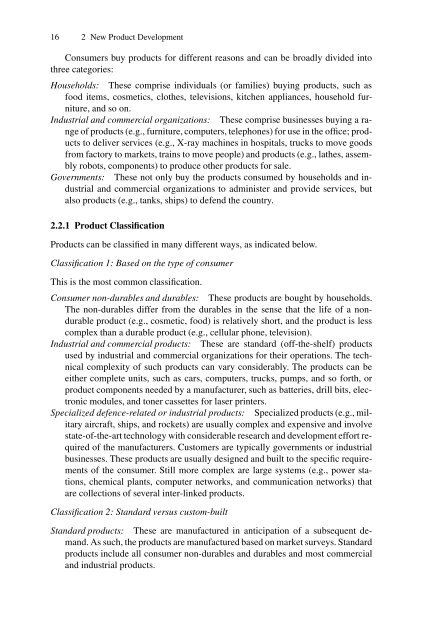9781848002708-c1
Create successful ePaper yourself
Turn your PDF publications into a flip-book with our unique Google optimized e-Paper software.
16 2 New Product Development<br />
Consumers buy products for different reasons and can be broadly divided into<br />
three categories:<br />
Households: These comprise individuals (or families) buying products, such as<br />
food items, cosmetics, clothes, televisions, kitchen appliances, household furniture,<br />
and so on.<br />
Industrial and commercial organizations: These comprise businesses buying a range<br />
of products (e.g., furniture, computers, telephones) for use in the office; products<br />
to deliver services (e.g., X-ray machines in hospitals, trucks to move goods<br />
from factory to markets, trains to move people) and products (e.g., lathes, assembly<br />
robots, components) to produce other products for sale.<br />
Governments: These not only buy the products consumed by households and industrial<br />
and commercial organizations to administer and provide services, but<br />
also products (e.g., tanks, ships) to defend the country.<br />
2.2.1 Product Classification<br />
Products can be classified in many different ways, as indicated below.<br />
Classification 1: Based on the type of consumer<br />
This is the most common classification.<br />
Consumer non-durables and durables: These products are bought by households.<br />
The non-durables differ from the durables in the sense that the life of a nondurable<br />
product (e.g., cosmetic, food) is relatively short, and the product is less<br />
complex than a durable product (e.g., cellular phone, television).<br />
Industrial and commercial products: These are standard (off-the-shelf) products<br />
used by industrial and commercial organizations for their operations. The technical<br />
complexity of such products can vary considerably. The products can be<br />
either complete units, such as cars, computers, trucks, pumps, and so forth, or<br />
product components needed by a manufacturer, such as batteries, drill bits, electronic<br />
modules, and toner cassettes for laser printers.<br />
Specialized defence-related or industrial products: Specialized products (e.g., military<br />
aircraft, ships, and rockets) are usually complex and expensive and involve<br />
state-of-the-art technology with considerable research and development effort required<br />
of the manufacturers. Customers are typically governments or industrial<br />
businesses. These products are usually designed and built to the specific requirements<br />
of the consumer. Still more complex are large systems (e.g., power stations,<br />
chemical plants, computer networks, and communication networks) that<br />
are collections of several inter-linked products.<br />
Classification 2: Standard versus custom-built<br />
Standard products: These are manufactured in anticipation of a subsequent demand.<br />
As such, the products are manufactured based on market surveys. Standard<br />
products include all consumer non-durables and durables and most commercial<br />
and industrial products.



